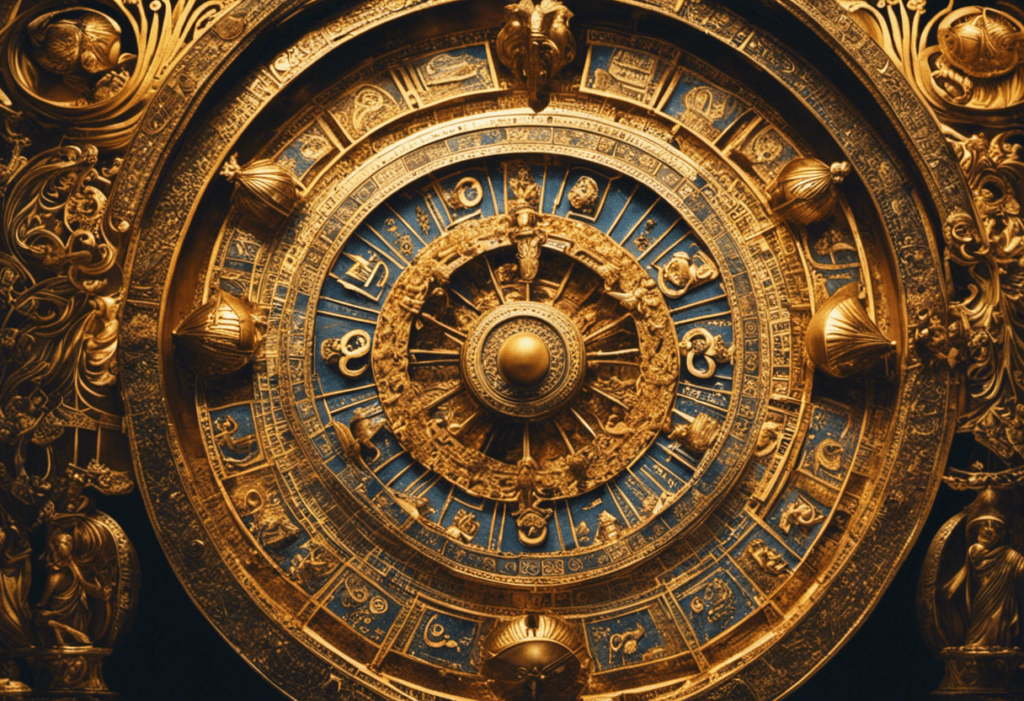Prepare to embark on a fascinating journey through the rich tapestry of Zoroastrian birth and death rituals.
In this article, we delve into the calendar perspective of this ancient faith, exploring the profound significance of these ceremonies and traditions.
Drawing upon extensive research and evidence, we present an objective and factual analysis, offering a comprehensive understanding of Zoroastrianism’s approach to honoring new life and bidding farewell to the departed.
Join us as we explore the beauty and depth of these sacred practices.
Key Takeaways
- Birth rituals in Zoroastrianism aim to protect and bless the newborn, emphasizing purity and creating a sense of unity.
- Zoroastrian Naming Ceremonies mark the introduction of a new member into the community, reflecting the family’s devotion to their faith and symbolizing integration.
- Zoroastrian festivals and rituals celebrate milestones, foster community togetherness, and reinforce beliefs, values, and cultural significance.
- Death rituals in Zoroastrianism honor and remember the departed, facilitate the spiritual journey, and emphasize collective support and remembrance.
The Significance of Birth Rituals in Zoroastrianism


The significance of birth rituals in Zoroastrianism is a topic that deserves careful examination as they play a crucial role in shaping the religious and cultural practices of the community. Zoroastrian birth ceremonies are deeply rooted in the cultural beliefs about birth in Zoroastrianism.
In Zoroastrianism, birth is seen as a sacred event that marks the beginning of a new life. It is believed that during the process of birth, the soul of the child is connected to the physical body, and therefore, birth rituals are performed to protect and bless the newborn. These rituals often involve prayers, purification ceremonies, and the recitation of sacred texts.
One key belief in Zoroastrianism is the concept of purity, both physical and spiritual. Birth rituals aim to ensure the purity of the child and protect them from any spiritual harm. They also serve to welcome the child into the community and establish their connection to the Zoroastrian faith.
Additionally, birth rituals in Zoroastrianism have historical and cultural significance. They reflect the traditions and customs of the community, preserving their cultural identity and passing it on to future generations. These rituals also create a sense of unity and belonging among Zoroastrians, reinforcing their shared values and beliefs.
Overall, the significance of birth rituals in Zoroastrianism cannot be overstated. They are not only religious ceremonies but also cultural practices that uphold the Zoroastrian identity and connect individuals to their community and faith.
Zoroastrian Naming Ceremonies: A Celebration of New Life


Several Zoroastrian families celebrate the arrival of a newborn through naming ceremonies and joyous festivities. These ceremonies hold great significance within Zoroastrianism, as they not only mark the introduction of a new member into the community but also serve as a means to bestow a name upon the child. The naming traditions in Zoroastrianism are rooted in ancient customs and beliefs, reflecting the values and principles of the religion.
Naming ceremonies in Zoroastrianism often take place on the sixth day after the child’s birth. This auspicious day is known as the ‘Navjote’ or ‘Navjot’. It is during this ceremony that the child is officially named and initiated into the Zoroastrian community.
The naming process involves choosing a name that carries positive connotations and reflects the family’s devotion to their faith. Names are often derived from religious texts, historical figures, or virtues that are revered in Zoroastrianism.
The naming ceremony is accompanied by various rituals and prayers, led by a priest or a family member. These rituals symbolize the blessings and protection sought for the child, as well as their integration into the religious and cultural fabric of the Zoroastrian community.
Zoroastrian naming ceremonies provide a sense of identity, belonging, and spiritual connection for both the child and their family. They serve as a reminder of the rich cultural heritage and religious traditions that continue to be cherished by Zoroastrians around the world.
Purification Rituals: Cleansing and Welcoming the Newborn
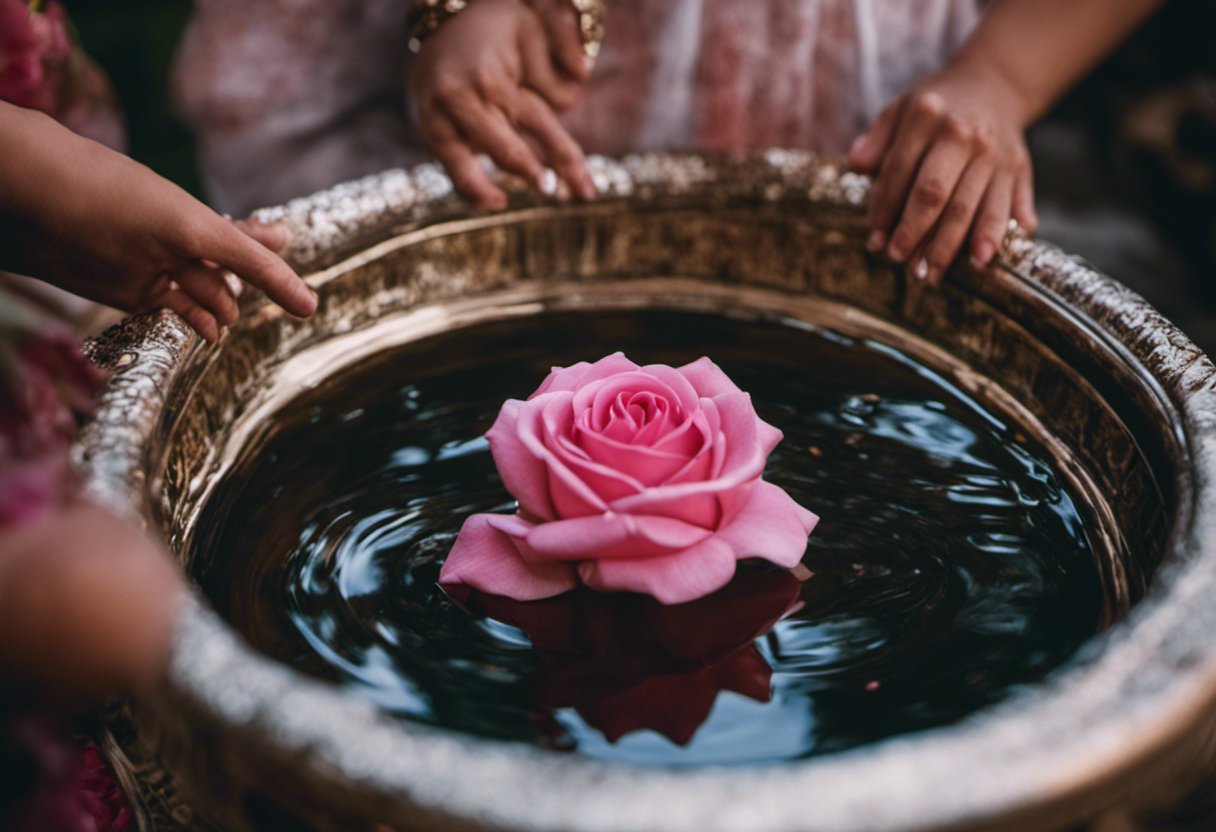

While Zoroastrian naming ceremonies are an integral part of welcoming a newborn into the community, purification rituals play a crucial role in cleansing and preparing the child for their spiritual journey. These cleansing rituals are rooted in the Zoroastrian belief system, which emphasizes the importance of maintaining purity and harmony in all aspects of life.
Zoroastrians believe that at birth, every individual enters the world with both spiritual and physical impurities. The purification rituals aim to cleanse the baby of these impurities and prepare them for a life of righteousness and devotion. The rituals typically involve the use of water, fire, and prayers, symbolizing purification and spiritual transformation.
One common purification ritual is the Nahn ceremony, where the child is bathed in sacred water infused with herbs and flowers. This act not only cleanses the physical body but also symbolizes the purification of the soul. Another important ritual is the sedreh pushi, where the child is dressed in the sacred white sedreh, a symbol of purity, and the kushti, a sacred thread representing the connection between the individual and the divine.
These purification rituals are often performed in conjunction with the naming ceremony, as they are seen as complementary aspects of welcoming the newborn into the Zoroastrian community. By cleansing the child and preparing them spiritually, these rituals lay the foundation for a lifetime of adherence to Zoroastrian principles and values.
Commemorating Life: Zoroastrian Festivals and Birth Anniversaries
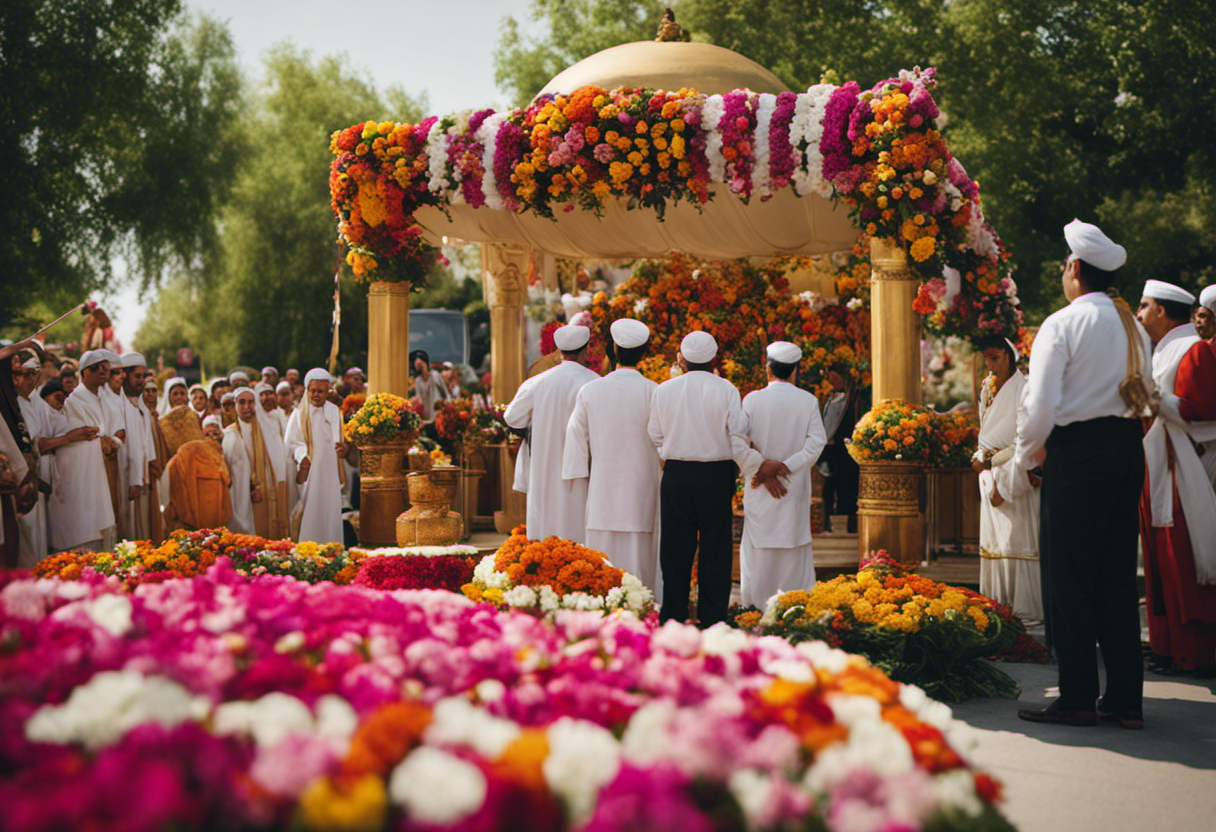

Commemorating life holds great importance in Zoroastrian culture. This is reflected in the various festivals and birth anniversaries celebrated by the community. These events serve as opportunities for Zoroastrians to honor and remember the lives of their loved ones. They also provide a chance to express gratitude for the gift of life.
Through traditional customs and practices, Zoroastrians create a sense of unity and continuity. These customs and practices reinforce their beliefs and values. They also foster a deep connection with their ancestors and the divine.
Festivals and Rituals
Zoroastrian festivals and rituals play a significant role in celebrating important milestones and fostering a sense of community among adherents. These traditions are deeply rooted in the Zoroastrian faith and hold cultural significance for the community.
Here are three key aspects of Zoroastrian festival traditions:
1) Gahambars: These are six seasonal festivals that celebrate the changing seasons and the bounties of nature. They provide an opportunity for the community to come together, engage in prayers, and partake in communal feasts.
2) Navjote: This initiation ceremony marks the transition of a Zoroastrian child into adulthood. It involves the investiture of a sacred thread and the acceptance of religious responsibilities.
3) Muktad: This ten-day period is dedicated to remembering and honoring the departed souls. Families visit the fire temples and offer prayers for their loved ones. It is believed that during this time, the souls of the departed return to their homes and receive the love and respect of their living family members.
These festivals and rituals not only hold deep religious significance but also contribute to the preservation of Zoroastrian culture and community cohesion.
Significance of Birth Anniversaries
Celebrating the birth anniversaries of individuals within the Zoroastrian community fosters a sense of belonging and strengthens intergenerational connections. Zoroastrian birth ceremonies are deeply rooted in cultural traditions and hold significant importance within the community.
These ceremonies mark the beginning of a new life and are a way to honor and welcome the child into the Zoroastrian faith. The rituals performed during these ceremonies vary depending on the region and family customs, but they often include prayers, blessings, and the tying of the sacred thread around the child’s wrist.
These rituals not only connect the child to their Zoroastrian heritage but also serve as a way for the community to come together and support the family. By upholding these cultural traditions, Zoroastrians ensure the preservation of their rich heritage and pass it down to future generations.
Traditional Customs and Practices
The preservation and transmission of traditional customs and practices in the Zoroastrian community is of utmost importance in fostering cultural identity and intergenerational connections. Zoroastrianism, one of the world’s oldest religions, has a rich history of rituals and ceremonies surrounding birth and death. These customs hold deep significance for Zoroastrians, as they serve as a way to honor their ancestors and maintain a strong sense of community.
Three key traditional customs and practices in the Zoroastrian community include:
-
Navjote: This initiation ceremony marks the entry of a Zoroastrian child into the religious community. It involves the tying of a sacred thread, known as the kusti, and is accompanied by prayers and rituals led by a priest.
-
Muktad: This annual 10-day period is dedicated to remembering and honoring the souls of the departed. Zoroastrians believe that during this time, the spirits of their ancestors return to the earthly realm. Special ceremonies and prayers are conducted to pay respects and seek blessings from these souls.
-
Tower of Silence: This unique burial practice involves placing the deceased on a raised structure, known as a dakhma or Tower of Silence, where their bodies are left to be consumed by vultures. This ritual is based on the belief in the sanctity of the elements and the importance of returning the body to nature.
It is through the observance of these traditional customs and practices that the Zoroastrian community upholds their cultural heritage and ensures the continuity of their religious traditions.
Death Rituals in Zoroastrianism: Honoring the Departed


Death rituals in Zoroastrianism are deeply rooted in the cultural and religious beliefs of the community. They serve as a means to honor and remember the departed individuals, while also facilitating their spiritual journey.
These rituals often include symbolic gestures, ceremonial prayers, and communal mourning practices, emphasizing the importance of collective support and remembrance in the grieving process.
Ritual Significance and Symbolism
Drawing upon rich cultural traditions, Zoroastrian death rituals embody the profound reverence for the cycle of life and the enduring legacy of the departed. Similarly, Zoroastrian birth rituals are deeply rooted in symbolism and cultural traditions. These rituals highlight the significance of new life and the continuation of the Zoroastrian community.
Here are three key aspects of Zoroastrian birth rituals:
-
Purification: Before birth, the expectant mother undergoes a purification ritual called ‘paiti’ to cleanse her spirit and ensure the well-being of both mother and child.
-
Naming Ceremony: Once the child is born, a naming ceremony called ‘Nām-kard’ is conducted, where the child is given a name that reflects their destiny and purpose in life.
-
Blessings and Prayers: The community gathers to offer blessings and prayers for the newborn, wishing them a life filled with happiness, health, and prosperity.
These birth rituals not only celebrate the arrival of a new life but also reinforce the cultural traditions and values of the Zoroastrian community.
Ceremonial Prayers and Chants
During Zoroastrian death rituals, individuals engage in the recitation of sacred chants and prayers, emphasizing the spiritual connection with the departed and the collective mourning process. These ceremonial invocations serve as a means to honor and remember the deceased, while also providing comfort and solace to the grieving community.
Religious chants play a crucial role in these rituals, as they are believed to have the power to guide the soul of the departed towards its final resting place. The recitation of these chants is considered a sacred duty and is often led by knowledgeable individuals within the community.
The use of religious chants in Zoroastrian death rituals reflects the central role of spirituality and the belief in the continuity of the soul after death in Zoroastrianism. These rituals not only provide a framework for mourning and remembrance but also reinforce the religious and cultural identity of the community.
Communal Mourning Practices
A significant aspect of Zoroastrian communal mourning practices involves the collective recitation of sacred prayers and chants, fostering a deep sense of unity and solace among the grieving community. This practice of coming together to commemorate loss and express grief is an integral part of the Zoroastrian tradition.
The following are three key elements of Zoroastrian communal mourning practices:
-
Reading of sacred texts: Zoroastrians gather to recite passages from their holy scripture, the Avesta, which contains prayers and hymns dedicated to the remembrance of the deceased. These readings serve as a way to honor and remember the departed, while providing spiritual guidance and solace to the mourning community.
-
Chanting of prayers: Chants, known as mantras, are an essential part of Zoroastrian mourning rituals. These repetitive prayers are believed to have a purifying and healing effect on the grieving individuals, helping them cope with their loss and find solace in their faith.
-
Ritualistic practices: Zoroastrians engage in various ritualistic practices during communal mourning, such as lighting candles, offering flowers, and performing symbolic gestures. These actions symbolize the transition of the departed soul and serve as a means of expressing grief and seeking divine blessings.
The Journey to the Afterlife: Zoroastrian Funeral Traditions
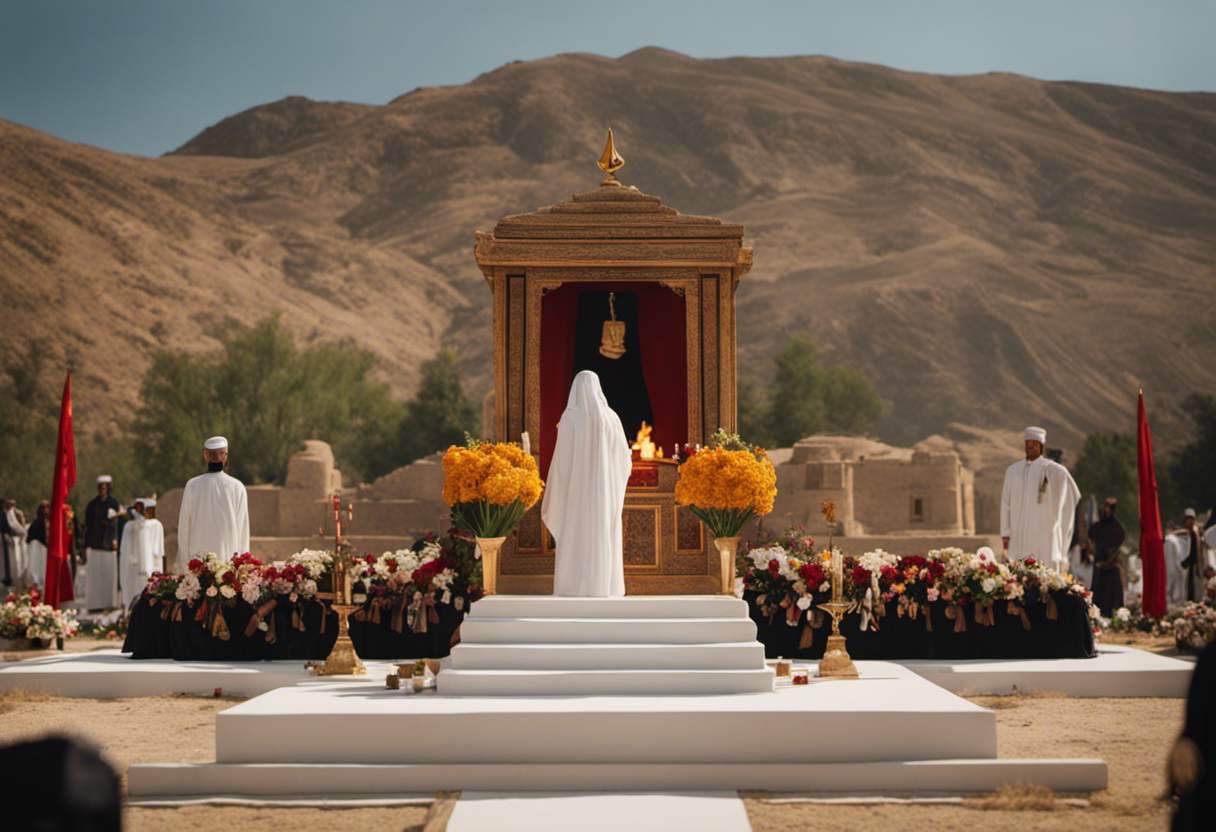

Three key rituals mark the transition from life to death in Zoroastrian funeral traditions. These rituals are an integral part of the Zoroastrian belief system, which views death as a passage to the afterlife and emphasizes the importance of honoring the deceased.
The first ritual is the funeral procession, which involves carrying the deceased’s body to the place of burial. This procession is a solemn and respectful event, with family and community members coming together to pay their respects.
The second ritual is the prayer ceremony, known as the Yasna, which is conducted by a priest and involves reciting sacred texts and offering prayers for the deceased’s soul. This ceremony is believed to help guide the soul on its journey to the afterlife.
The third and final ritual is the placement of the body in the Tower of Silence, a circular raised structure where the body is exposed to the elements and left to decompose. This practice is based on the Zoroastrian belief in the purity of the elements and the importance of returning the body to nature.
These rituals for the deceased reflect the Zoroastrian belief in the continuity of life and the importance of spiritual rituals in honoring and guiding the departed soul.
Mourning and Remembrance: Zoroastrian Practices for Grieving and Commemoration
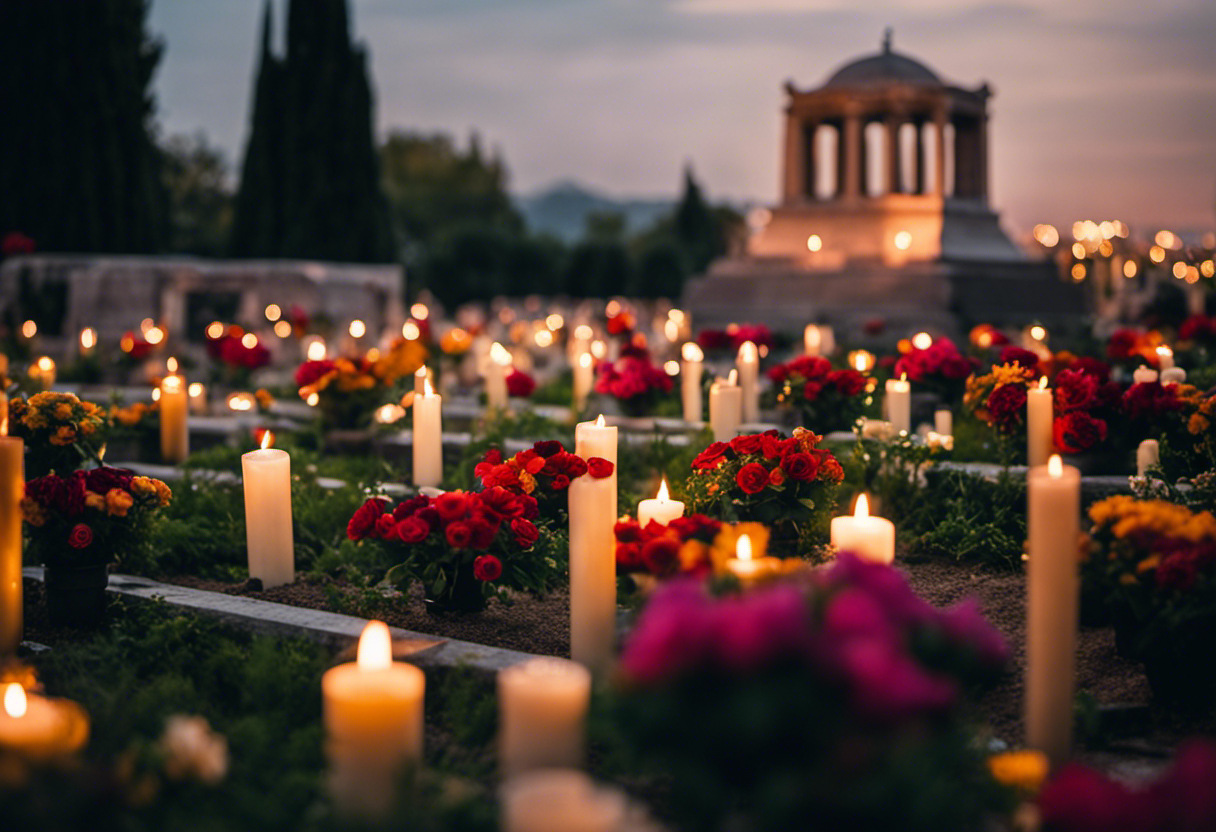

Zoroastrian practices for grieving and commemoration involve rituals and ceremonies that honor and remember the deceased. These practices play a significant role in the mourning traditions and grieving process within the Zoroastrian community.
Here are three key aspects of Zoroastrian practices for grieving and commemoration:
-
Washing and preparation of the body: Upon death, the body is ceremonially washed and prepared by close family members. This ritual is considered a sacred duty and is performed to cleanse the body and prepare it for the afterlife.
-
Funeral rituals: Zoroastrian funeral rituals typically involve a prayer ceremony known as the ‘Muktad’ which lasts for ten days. During this period, special prayers are recited to honor and remember the departed soul. Offerings such as flowers, incense, and food are made to the deceased’s spirit.
-
Annual remembrance: Zoroastrians commemorate the anniversary of a loved one’s death through an annual ceremony called ‘Frawardigan.’ This ceremony involves prayers, offerings, and acts of charity to honor the deceased and ensure their continued spiritual well-being.
Zoroastrian mourning traditions and grieving process reflect the community’s belief in the importance of honoring and remembering the departed. These rituals provide a sense of closure and continuity, allowing the bereaved to navigate the grieving process with the support of their religious community.
Conclusion
In the rich tapestry of Zoroastrianism, birth and death rituals hold profound significance. From the joyous celebration of new life through naming ceremonies and purification rituals to the solemn honoring of the departed through funeral traditions and grieving practices, these rituals encompass the cycle of human existence.
By delving into the cultural and religious perspectives surrounding these rituals, we gain a deeper understanding of the beliefs, values, and traditions cherished by the Zoroastrian community.



